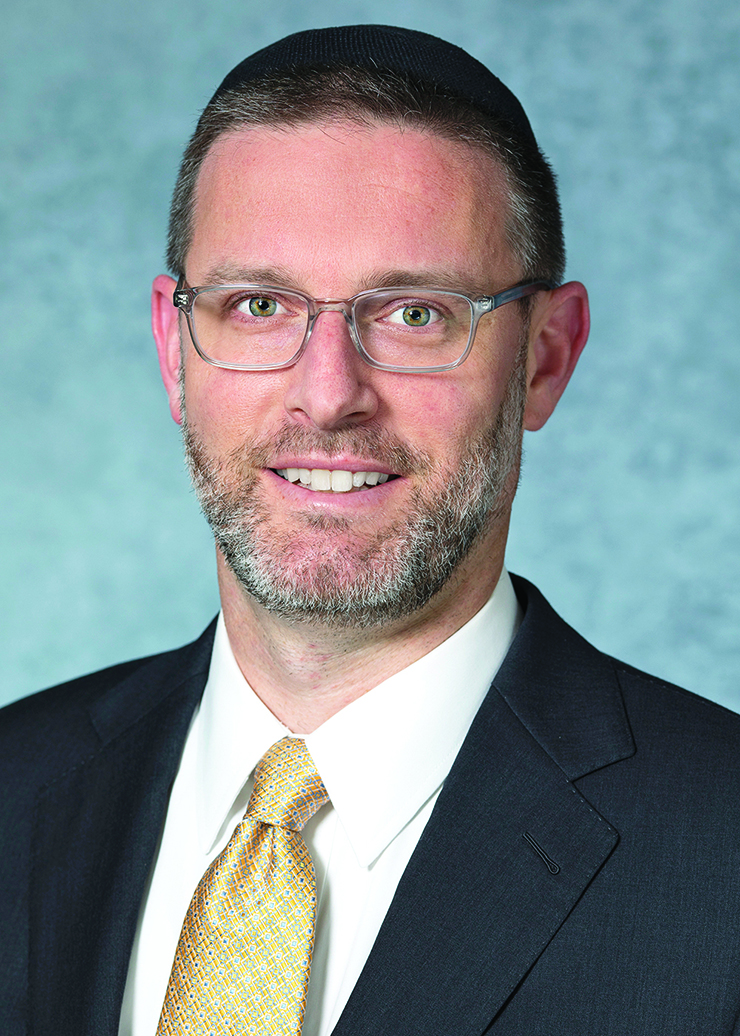Research in new Touro journal addresses halachic ramifications of technology’s transformation of healthcare.

(Courtesy of Touro University) Advances in technology are shaking up education and the workplace. New developments such as artificial intelligence and CRISPR gene editing technology are also transforming healthcare. Rabbi Jason Weiner, senior rabbi and executive director, spiritual care department at Cedars-Sinai, published research on this topic in the second volume of the Medical Halachah Annual journal, recently released by Touro University and New York Medical College.
In this Q&A, Rabbi Weiner shares information and insight on the benefits and dangers of new technology as well as the Jewish perspective on emerging scientific and medical technology.
How does AI help physicians work more efficiently?
AI-augmented healthcare has the potential to help physicians be better doctors and thus save and enhance patients’ lives in many ways. For example, by reading scans much faster and more accurately than a human radiologist can and incorporating data from millions of scans instantaneously to recognize abnormalities, or by assessing and diagnosing cardiac function on echocardiogram, AI enables extremely accurate and perceptive diagnostics and the ability to predict future health needs. With this accuracy and perceptibility, AI can also reduce accidental deaths and injuries, and increase productivity. With AI, physicians can work faster and more efficiently than humans while recognizing issues that a human would be unable to perceive. AI is even developing the ability to innovate and generate new scientific knowledge and discoveries.
What concerns does the observant Jewish community have about using AI in a healthcare setting?
There are several concerns and I’ll highlight two. Firstly, AI is becoming a central part of decision-making, such that instead of asking the patient, physicians, and perhaps a rabbi for the path to follow, algorithms will begin predicting outcomes and recommending the best course of action for that patient. The problem is that many decisions don’t simply involve statistics and probabilities. They often depend on values, whether they be related to the sanctity of life, the role of age in medical decision making, or what is considered an acceptable level of risk. However, AI is known to reflect human biases, and it is almost certain that some values will end up being “programmed” into the AI that do not reflect Jewish values. Since we rarely know all of the factors that go into AI decision-making, this could be a major concern for someone who has their own value system, such as an observant Jew.
Secondly, although AI can vastly improve efficiency in patient care, this can also lead to impersonalization. As healthcare becomes increasingly dictated by computers and AI, this leads to a lack of personal empathy, compassion, and a relationship with a healthcare provider, all of which can be essential to the therapeutic process. This also leads to concerns of patients becoming socially isolated and lonely. Given that Judaism emphasizes the centrality of refuas hanfesh, this could be a potentially very concerning change in the practice of medicine that we should be trying to prevent.
How can these issues be addressed?
Some possible strategies for mitigating these concerns include advocating for a shift in medical education from a focus on knowledge recall to training students to interact with and manage AI effectively, including the ethical complexities that may arise, and helping them to improve communication and empathy skills. This goes along with advocacy for enabling clinicians to be allowed to have more time to get to know each patient and what makes them unique, so that they can recenter their focus to human needs, spending quality time with their patients on meaningful matters, and providing the human touch and empathy necessary for truly patient-centered care. More specifically to the Jewish community, we need to better train and encourage our community volunteers, bikur cholim groups, chaplains and rabbis to redouble efforts to provide supplemental holistic, supportive, whole-person care for those who are hospitalized.
I believe that we need to both advocate for requiring transparency and striving to make AI systems as explainable as possible to those who utilize it, and train religious experts whose job it would be to ensure that patients’ values are being respected. This would be a sort of a techno-mashgiach who could understand the technology and be able to explain to rabbanim which factors and values went into AI’s decisions, and educate our community so that together we ensure that halacha is followed properly. Such individuals may be able to help identify alternate AI programs; assist rabbis and patients in understanding the embedded values of particular programs; and explain the calculations that go into the recommendations that AI makes so that we can better understand why it recommends a certain surgery, treatment or triage decision, and help the rabbi determine if we agree with a particular recommendation or not, based on the many applicable halachic principles relevant to these decisions.
Can you describe how CRISPR gene editing technology works?
CRISPR (clustered regularly interspaced short palindromic repeats) gene editing is a transformative new technology that can change an organism’s DNA by either adding, removing or altering genetic material at particular locations in the genome. This technology was adapted by scientists based on a genome editing process that happens naturally in some bacteria as an immune defense by capturing small pieces of a virus’s DNA and inserting them into its own DNA. In that process, the bacteria learn how to recognize the virus and then cut it apart to disable it if it attacks again. Germline gene editing is when edits are made in reproductive cells (human eggs or sperm) or an early-stage embryo, thus making inheritable changes that will be passed along to all of the cells of all future generations of that individual. This process can thus completely alter humankind.
What is the halachic view on altering genes? Is there a difference when it’s done to fix genetic abnormalities or eliminate genetic illnesses vs. enhancing human capacity or genetic traits?
Very few rabbis have addressed this issue so far, but we can make some inferences from halachic approaches to other technologies, such preimplantation genetic testing (PGT), which many rabbis did discuss. There is significant discussion in this field on distinguishing between medical therapy/treatments that are focused on fixing dangerous genetic abnormalities versus enhancements that are intended to improve human capacities or traits. Most rabbis argue that health treatments are more justifiable than enhancements. It can sometimes be difficult to distinguish those categories, and it is possible that rabbinic authorities may permit not only medical therapies, but also some forms of enhancement, if these are deemed essential for basic quality of life. Where the red line seems to lie amongst rabbinic authorities would be in creating new capabilities that have never before existed naturally in human beings (“super-enhancements”), such as the ability to see infrared light. Such changes are seen as going too far in “playing God.”
What is the Jewish perspective on new and emerging scientific and medical technologies?
Judaism supports what is known as “the precautionary principle.” This is the view that when new therapies and technologies can cause unknown harm to the world or potentially negative consequences for generations to come, the burden of proof regarding their safety must be thoroughly demonstrated by those advocating for the new therapy or policy before moving forward with it. This is especially so in the case of CRISPR, since science has demonstrated that the human genome is more complex than previously thought, and our capabilities may thus proceed faster than our knowledge about the precise outcomes of applying this new technology. This approach seeks to limit harm while at the same time recognizing that research should move forward—but only when we are ready and can proceed with caution. The precautionary principle is thus temporary, with the goal of eventually creating permanent benefit for humanity.
In discussing this with Rav Asher Weiss, he suggested that when the goal is saving life, we should seek to encourage new technologies to progress as quickly as possible, but with caution. He compared this to driving an ambulance to save a life. The ambulance should be driven as speedily as possible to reach the patient in need. However, it would be irresponsible to drive recklessly since that would in fact jeopardize the ambulance’s likelihood of saving the life.













